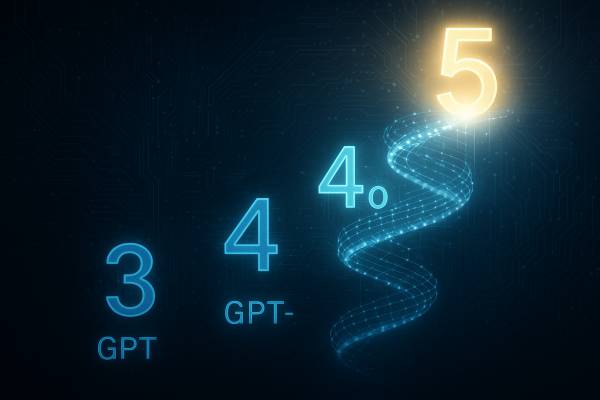The development of artificial intelligence has accelerated rapidly in recent years, reaching a point where news about increasingly advanced models is emerging at an almost overwhelming pace. In this noisy environment, it’s difficult for any new development to stand out, as it must be more and more impressive to cross the threshold of user interest. OpenAI carries a double burden in this regard: not only must it continue to innovate, but it also needs to maintain its lead over fast-advancing competitors. It is into this tense landscape that OpenAI’s newly unveiled GPT-5 model family has arrived—eagerly anticipated by critics who, based on early announcements, expect nothing less than a new milestone in AI development. The big question, then, is whether it lives up to these expectations. In this article, we will examine how GPT-5 fits into the trajectory of AI model evolution, what new features it introduces, and how it impacts the current technological ecosystem.
Competition among companies offering AI solutions is extremely fierce, which is why differences between models are now measured not only in terms of accuracy or speed but also in ethical standards and customizability. Therefore, the development of GPT-5 aimed not only to improve performance but also to enable more intelligent, secure, and personalized interactions with users. The new model not only delivers more accurate responses but is also capable of more deeply interpreting user intent. That’s why OpenAI likes to present this model not just as a tool but as a digital partner—now freely available under the Apache 2.0 license.
The GPT-5 Model Family
The GPT-5 family includes three main versions: the standard GPT-5 model, the smaller and faster GPT-5 Mini, and GPT-5 Pro, which offers enhanced reasoning capabilities. One of the most important innovations compared to previous systems is that users no longer need to manually choose between different models. ChatGPT now automatically adapts to the complexity of each task, so model selection happens in the background. However, Pro users still have access to the dedicated GPT-5 Pro model, which has been specifically optimized for solving the most complex problems.
The technical architecture behind these models is based on the Mixture-of-Experts (MoE) concept. This means the system activates only the most relevant submodules for each task, significantly reducing computational requirements without compromising performance. Additionally, the model can dynamically switch between full attention and sliding window mechanisms thanks to an optimized layer structure. Memory efficiency is further improved by using the more compact MXFP4 format instead of bfloat16, which remains compatible with modern GPUs.
But the system is not just faster—it’s also more accurate. It can intelligently switch between everyday conversation and argumentative reasoning, based on a built-in "thinking" mechanism. As a result, the model analyzes complex queries step by step and is less likely to produce incorrect or misleading answers. According to OpenAI, the number of factual errors has decreased by 45%, and both instruction-following and honesty have improved significantly.
OpenAI has also introduced a new response format called the Harmony Response Format. This enables more fine-tuned replies, communication across multiple channels, and the delivery of advanced meta-information. Although this requires more resources, it greatly enhances the user experience. Another innovation is that the ChatGPT interface has become more customizable: users can now choose from various color palettes and select from pre-configured "personalities" representing different response styles.
GPT-5 Capabilities and Practical Applications
GPT-5 is not just another language model—it increasingly appears to be a system with capabilities far beyond traditional text-based interactions. The goal was not simply to make the model recognize more words or express itself more eloquently, but to make artificial intelligence truly integrable into a wide range of practical applications. This shift in perspective is clearly reflected in GPT-5’s functionality.
Let’s start with coding, as one of OpenAI’s primary focuses remains serving the developer community. One of the most exciting new features of GPT-5 is “Vibe Coding”, which allows users to create applications or websites based on natural language descriptions. This is not just a marketing buzzword, but a concrete feature for developers: all a user needs to say is something like, “I want a clean, mobile-friendly portfolio page with a dark background and a simple contact form,” and GPT-5 can generate working HTML+CSS or even React code. More importantly, it doesn’t rely on pre-made templates but generates code snippets tailored to the specific request—with real-time preview capabilities. This functionality is already integrated into Copilot within Microsoft Visual Studio Code, meaning developers can incorporate GPT-5 directly into their daily workflows.
But it’s not just developers who have reason to celebrate. GPT-5 has become significantly more customizable. As mentioned earlier, four new AI “personalities” have been introduced for research purposes in the chat interface—not just as stylistic settings, but as distinct systems that respond with different communication logics. These include sarcastic (Cynic), sterile and precise (Robot), understanding and patient (Listener), and playful and curious (Nerd) personas. Although still experimental, these developments show where OpenAI is heading: it increasingly aims to build a system that not only conveys information but also personally resonates with the user.
In terms of functionality, GPT-5 no longer “just” generates text—it is also capable of executing more complex tasks through function calling. This means that, with user permission, the model can independently access external tools, such as browsing web resources or using a code execution environment. While these ideas aren’t entirely new, GPT-5’s implementation is noticeably smoother and more reliable. For example, the system can compile an agenda by integrating with Gmail and Google Calendar, reviewing incoming emails and calendar events. This is undoubtedly convenient, though it also raises concerns around data privacy. OpenAI is aware of these issues and offers options for fine-tuning these functions.
In summary, GPT-5’s practical applications have clearly expanded, while requiring less technical setup from the user. All of this suggests that GPT-5 is not just another generation of models, but a meaningful step toward AI-based personal and professional assistants.
GPT-5 Availability and Access Options
OpenAI has likely learned from the rollout of previous generations, as access to GPT-5 is now much more structured than it was, for example, with GPT-4o. The release is taking place in stages, with particular attention paid to assigning different functionalities to different subscription tiers.
Free users also have access to GPT-5, but their usage is clearly limited. After a few requests per day, the system automatically switches to the less powerful but faster GPT-5 Mini model. This switch is fully automated and cannot be manually overridden, but it does result in faster response times. The free tier also includes a version of GPT-5 capable of “deeper thinking” (GPT-5 Thinking), which is available once per day.
In contrast, Plus and Pro subscribers enjoy significantly broader access. Plus users can ask up to 80 questions every three hours, with hundreds of interactions per week in Thinking mode, while the Pro package offers virtually unlimited usage. This is not only a quantitative difference but also a qualitative one, as the Pro plan includes the GPT-5 Pro model, which has been specifically optimized for solving complex, multi-step tasks.
Access through the Microsoft ecosystem also deserves special mention. The Azure AI Foundry platform allows developers to access GPT-5 models directly and even integrate them into their own applications. OpenAI’s model router technology is also embedded here, which automatically determines in the background which GPT-5 version is best suited for a given task. This flexibility is particularly valuable for those who not only want to use the model but also build services around it.
Last but not least, there are the new open-weight models, GPT-OSS-20B and GPT-OSS-120B, which are available under the Apache 2.0 license. It’s important to note that these models are not open-source, only open-weight, as the training data and processes remain undisclosed. However, these models are now suitable for local execution, even on medium-performance GPUs. With this step, OpenAI is reaching out to researchers and developers who wish to study, test, or further develop the technology on their own infrastructure. This is clearly an important direction, as the future of artificial intelligence will depend not only on who can build the largest model, but also on who makes it accessible to the wider community.
The smaller model is already operational with 16 GB of memory, which is sufficient for most modern developer machines, while the larger model requires 80 GB of VRAM—meaning an NVIDIA A100 should be sufficient. Thanks to Microsoft’s support for ONNX Runtime, these models can run on Windows, making the use of open models a real possibility—not just in theory, but in practice.
GPT-5 in the Microsoft Ecosystem
One of the most important aspects of GPT-5’s introduction is how deeply it is integrated into Microsoft products. The strategic partnership between OpenAI and Microsoft is not new, but with GPT-5, the collaboration has reached a new level. The model is not only accessible through Microsoft services, but is also organically embedded in their functionality. So, beyond what has already been mentioned, let’s take a closer look at what this integration actually looks like.
Let’s start with Microsoft 365 Copilot, the latest version of which now runs on GPT-5. This not only means more accurate and faster responses in Word or Outlook, but also that the AI can handle more complex, context-sensitive tasks. With previous models, it was common for the system to “lose the thread” during longer conversations. GPT-5, however, is now capable of following more intricate narratives and providing relevant responses based on the combined interpretation of multiple emails, documents, and calendar events.
Another major step forward for developers is that GitHub Copilot and Visual Studio Code now support GPT-5. The system not only generates code faster, but also understands complex logical relationships more effectively. For example, Copilot powered by GPT-5 can not only identify the location of an error based on the error message but also suggest rethinking the entire logic structure—potentially saving a lot of time. Meanwhile, the user can continuously roll back changes using the Checkpoint feature.
A further significant development is the so-called Model Router, which essentially acts as a background model selection system. Users no longer need to decide whether GPT-5 Mini or Pro is the better choice for a specific task—the system makes that decision automatically, based on the complexity of the request and environmental parameters. This is especially effective in large enterprise environments, where not just a single user’s interaction needs to be served, but thousands of different tasks with varying AI processing needs must be handled simultaneously.
We should also mention the Copilot Studio developer platform, where you can build your own AI agents based on GPT-5. This allows for the creation of chatbots, assistants, or workflow systems tailored to the internal needs of an organization—solutions that are no longer “general-purpose” AIs but ones specifically optimized for their intended context. In such cases, GPT-5 doesn’t just provide information—it can also learn from user interactions and gradually adapt to the organization’s operations.
In summary, Microsoft has not only made GPT-5 accessible, but has integrated it into the digital workspace as a system-level tool. This deep integration allows artificial intelligence to become a truly useful asset—no longer just an impressive demo in a presentation, but a practical, everyday tool.
Challenges and Future Directions
As impressive as the technological level of GPT-5 is, it is important to keep both feet on the ground. The directions of development raise at least as many questions as they offer opportunities. These questions may not be spectacular or easy to communicate, but they are critical when it comes to how sustainable and reliable the continued spread of AI-based systems will be.
One of the most tangible challenges is scalability. The architectures behind GPT-5, such as the Mixture-of-Experts system, represent a significant advance in efficiency, but still require substantial hardware. Open-weight models are available for smaller configurations, but the full GPT-5 Pro experience still demands significant resources. This situation inevitably creates a technological divide between those who have access to these resources and those who do not.
Another, more serious issue is security and ethical operation. OpenAI is clearly attempting to address these concerns proactively: it has introduced new safety mechanisms (such as "Safe Completions"), conducted thousands of hours of internal testing, and adopted a more transparent communication strategy. However, due to the nature of the problem, there is no such thing as a “finished” state—AI systems are not static; they learn, evolve, and may exhibit new, unexpected behaviors over time.
A third and increasingly pressing challenge is user transparency and credibility. GPT-5 is already capable of generating responses that are convincing and coherent—but not necessarily true. While the model is more likely to signal uncertainty, it can still produce convincing yet false information—an especially sensitive issue in fields such as healthcare, education, and law.
Looking ahead, two main directions can be identified. One is toward personalization, where users can increasingly influence how the system thinks and communicates with them. The other is toward openness and transparency, which is important not only from a developer perspective but also in terms of public trust. The rise of open-weight models represents the first serious step in this direction.
Summary
When we started writing this article, we asked: how can a new model—in this case, GPT-5—stand out in the almost overwhelmingly crowded AI landscape? OpenAI’s new model family didn’t arrive in a vacuum, but in an environment where new “revolutionary breakthroughs” are promised every week, and users’ thresholds for excitement are getting higher and higher. GPT-5 had to prove itself in this context—and while it may not have delivered a historic breakthrough, it has definitely set the direction.
From a technological standpoint, GPT-5 is clearly a step forward. Based on the model’s performance, accuracy, flexibility, and safety improvements, it can justifiably be considered a new level compared to previous versions. New architectures, customizability, deeper reasoning, and the ability to call functions all point toward AI becoming less of a responder and more of a partner.
At the same time, it is important to recognize its limitations. GPT-5 does not solve all the issues surrounding AI. It doesn’t settle debates around authenticity, data security, or social impact. But that’s not its role. What it does is lay a new foundation on which to build—whether for personal assistants, development environments, or enterprise systems.




































